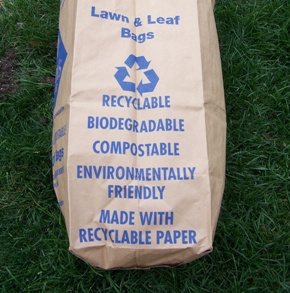Image by Getty Images via Daylife
I really wish that was not the case but it is. I have written and spoken on this topic numerous times but a recent reader response on this blog from Neil Hunter in the UK has motivated me to address it once again.
I think we all hope that eventually there will be consistent and clear definitions, and terms like eco-friendly, sustainable, compostable, biodegradable will all mean the same thing to everyone. But that is not the case today or probably any time soon.

When in doubt, claim everything?
There are certain packaging product areas where green has an even greater amount of “gray” and that most definitely includes bio-plastics. Consider the variety of products and applications out there and you will see the obvious problem. To me “plastics” means packaging films for wrapping, shrinking and forming. To our reader Neil, plastics are about disposable cutlery. Can “standards” ever be the same for both of us?
Bio-Plastics moving in the right direction
A couple of weeks ago I spent two days at the Pack Expo show in Chicago and I was very impressed and encouraged at how far bio-plastics have come in the last two years since Pack Expo 2006. There have been great advancements in terms of quality, performance, clarity, and even in the area of biodegradability. Selection and variety have improved, and minimums are becoming more reasonable while cost continues to grow more competitive with “standard” non-eco marketed products.
Not surprisingly the packaging industry appears to be much better informed than the average consumer and eventually that gap will hopefully narrow. For example, many times I have read statements, sincerely believed to be based in fact, that PLA based bio-plastics are depleting the earth’s supply of corn for food and contributing to the global hunger problem. I have yet to see anything in print, from a reliable scientific source that supports what can only be described as a sustainability urban legend.
However, Neil’s question and concern about the compostability of some of these newer plastics is legitimate and appropriate. Thankfully I believe there is a growing concern among consumers about what happens next. Is that product, or packaging biodegradable, compostable – or the latest green solution of the month, “oxo”-degradable – and if so, under what conditions? This stuff does not evaporate, so where does it go? As consumers we have the right if not responsibility to ask these questions of manufacturers and it is perfectly fine green etiquette to ask them to support their claims in writing and with data.
The Globe Guard Approach
As a company that outsources manufacturing, we have been instrumental in the development of several new “green” products that are now in use, by listening to our customers and understanding their needs as well as their concerns. In other words, we don’t take products to market, we take solutions to market and that is a considerably different approach than creating a product and then trying to determine where you can sell it.
We also accept the fact that in some product categories, the perfect product and green packaging solution does not yet exist so we take the good, better, best approach to evaluating a new product and determining if and how it fits into our product line. Amid all the confusion, distortion and green noise, there are some points that are inarguable and they form the foundation of our ranking process in regards to sustainability,
- Recycled content is better than virgin content
- The greater the percentage of recycled content the better
- Post consumer waste is better than post production waste
- Up-cycling is better than recycling
- Reusing is better than recycling
- If up-cycling and reusing are not viable options, the easier it is for any product to be recycled, the better
- The fewer the limitations on a products’ biodegradability, the better
Not too long ago, a manufacturer of a “biodegradable” garbage bag received a well deserved black eye in the media because the only way their bag would degrade is if it was subject to sunlight, air and moisture. Since most garbage bags wind up buried deep in landfills where by design neither sunlight, air nor water are likely to get to them, this made their biodegradable claim impractical if not outright deceitful.
One day green will indeed be black and white but for now the Latin term caveat emptor is still appropriate. After all the knowledge and science we now have working for us and endless government involvement and regulations designed to protect us from ourselves, it is ironic that centuries old phrase, “Let the buyer beware” is still the best advice we have to offer.
______________________
 Visit the Globe Guard Eco Friendly Packaging Store for –
Visit the Globe Guard Eco Friendly Packaging Store for –
Eco Friendly Shipping Supplies
Special Deals on Packaging Supplies
and more!



